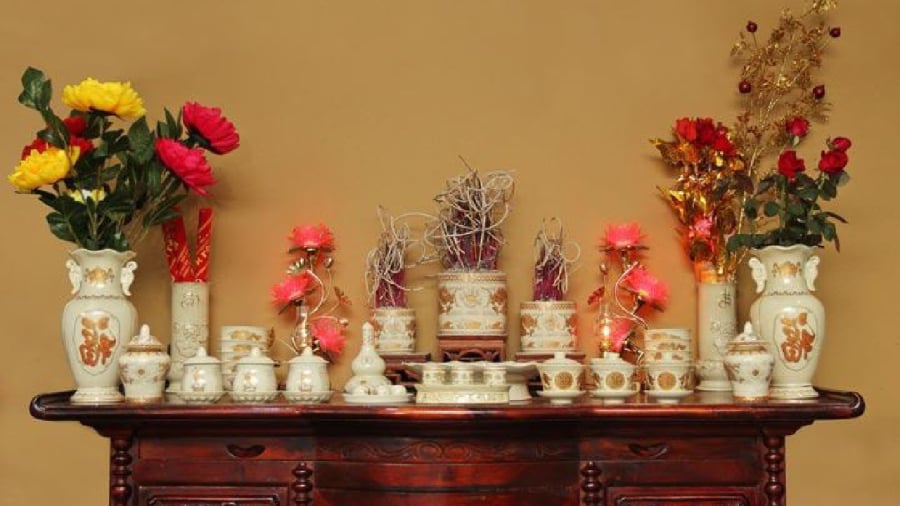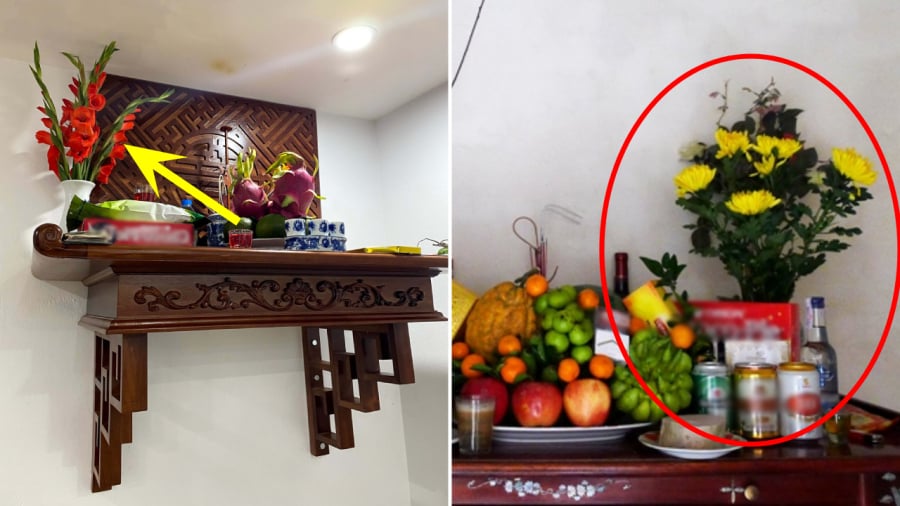Why shouldn’t the vase of flowers on the altar be placed on the right?
On special occasions, the full moon, the new moon, and death anniversaries, fresh flowers are a must-have offering on the altar. Placing at least one vase of fresh flowers on the altar expresses the sincerity of the descendants towards their ancestors and deities, while also carrying the intention of gathering and accumulating wealth.
Fresh flowers bring vitality and are considered a convergence of the essence of the earth and sky. Placing a vase of flowers on the altar not only makes it fragrant and enhances its solemnity and tranquility but also boosts the family’s fortune and attracts prosperity. However, the placement of flowers on the altar should not be taken lightly.
Usually, on the altar, the host can place one or two vases of flowers depending on the size of the altar and the family’s needs and conditions.
If placing two vases (a pair) on the family ancestor’s altar, the host only needs to arrange the vases symmetrically on both sides and place a tray of flowers and fruits in the middle, in front of the incense holder. This arrangement creates a balanced setup for the altar while also preserving the spiritual meaning.

In the case of placing two vases of flowers on the altar, the host only needs to place one vase on each side to create symmetry.
However, if only using one vase of flowers, the host needs to pay attention to its placement. In this case, the principle of “East for the vase and West for the fruits” should be followed, meaning the vase of flowers should be placed in the East and the fruits in the West.
This principle has been passed down from ancient times by our ancestors. It originates from the natural law that the sun rises in the East and sets in the West, and trees blossom before bearing fruit. Therefore, when arranging offerings on the altar, placing the vase of flowers in the East and the fruit tray in the West symbolizes this natural cycle.
To determine the left and right sides of the altar according to the East-West direction, the host should do the following: Stand facing the altar, the left side from your perspective is considered the East (left), and the opposite side (the right side from your perspective) is considered the West (right). This is the common belief passed down from ancient times.
According to this direction determination, the vase of flowers should be placed on the left side of the altar, and the tray of five types of fruits should be placed on the right. The host should pay attention to determining the correct direction to avoid placing the vase of flowers on the right and the fruit tray on the left.

The vase of flowers on the altar should be placed on the left, not on the right (for altars with only one vase), following the principle of “East for the vase and West for the fruits.”
Other notes on placing flowers on the altar
The vase of flowers is an indispensable offering to enhance the solemnity and sacredness of the worship space. If the altar is small, especially in the case of a hanging altar, the host can use just one vase of flowers and place it on the left side. If the altar is spacious, a larger vase of flowers can be used, and two vases can be placed symmetrically on both sides to create a balanced look.
The vase of flowers on the altar should also ensure aesthetic value and be sturdy and of good quality.
When arranging flowers, the host should use fresh flowers instead of dried or artificial ones. When the flowers wither, they should be promptly replaced with fresh ones, and the wilted flowers should not be left on the altar for too long.
This information is for reference only and is subject to individual interpretation.
The Three Items on the Altar That Need to Be Removed After the Full Moon Ceremony for Prosperity
“After the paper money burning ritual, it is imperative for the host family to take down the offerings from the altar. It is of utmost importance to remember that there are three specific items that must be removed from the altar; leaving them there could potentially lead to bad luck and financial difficulties for the family.”
The 5 Things You Should Never Place Under an Altar
In the realm of feng shui, it is imperative to maintain a pristine and orderly space for the altar. This sacred area must be treated with the utmost respect, free from any clutter or random objects that could disrupt the harmonious flow of energy. It is believed that a tidy altar space invites positive energy and brings peace and prosperity to the home.



































